Practicing the CBSE Sample Papers for Class 12 Physics with Solutions Set 7 allows you to get rid of exam fear and be confident to appear for the exam.
CBSE Sample Papers for Class 12 Physics Set 7 with Solutions
Time : 3 Hours
Maximum Marks: 70
General Instructions :
- There are 35 questions in all. All questions are compulsory.
- This question paper has five sections: Section A, Section B, Section C, Section D and Section E. All the sections are compulsory.
- Section A contains eighteen MCQs of 1 mark each, Section B contains seven questions of two marks each, Section C contains five questions of three marks each, Section D contains three long questions of five marks each and Section E contains two case study based questions of 4 marks each.
- There is no overall choice. However, an internal choice has been provided in Section B, C, D and E. You have to attempt only one of the choices in such questions,
- Use of calculators is not allowed.
Section – A
The following questions are multiple-choice questions with one correct answer. Each question carries 1 mark. There is no internal choice in this section.
Question 1.
If charge q is placed at the centre of the line joining two equal charges Q, the system of these charges will be in equilibrium if q is:[1]
(a) -4Q
(b) -Q/4
(c) -Q/2
(d) +Q/2
Answer:
(b) -Q/4
Explanation: For equilibrium, net force on Q = 0.
Let, the distance between line joining two equal charges Q is x unit.

Question 2.
The electric potential inside a conducting sphere:[1]
(a) increases from centre to surface
(b) decreases from centre to surface
(c) remains constant from centre to surface
(d) is zero at every point inside
Answer:
(c) remains constant from centre to surface
Explanation: Electric potential inside a conductor is constant and it is equal to that on the surface of the conductor.
Question 3.
According to the Kirchhoff’s law, in any analytic circuit, if the direction of current assumed to be opposite, then the value of current will be:[1]
(a) i
(b) 2 i
(c) – i
(d) 0
Answer:
(c) – i
Explanation: According the Kirchhoff’s law, in any analytic circuit, if the direction of current assumed to be opposite, then the value of current will be – i.
Question 4.
A particle of mass m and charge q enters a magnetic field B perpendicularly with a velocity v. The radius of the circular path described by it will be:[1]
(a) \(\frac { mq }{ Bv }\)
(b) \(\frac { Bq }{ mv }\)
(c) \(\frac { mv }{ Bq }\)
(d) \(\frac { mB }{ qv }\)
Answer:
(c) \(\frac { mv }{ Bq }\)
Explanation:
Force, F = qvB = \(\frac { mv² }{ R }\)
∴ R = \(\frac { mv }{ Bq }\)
![]()
Question 5.
A 2 MeV proton is moving perpendicular to a uniform magnetic field of 2.5 T. The force on the proton is:[1]
(a) 2.5 x 10-10 N
(b) 2.5 x 10-11 N
(c) 7.6 x 10-11 N
(d) 7.85 x 10-12 N
Answer:
(d) 7.85 x 10-12 N
Explanation: We know that,
F = qvB
= 1.6 x 10-19 x \(\left(\sqrt{\frac{2 \mathrm{E}}{m}}\right)\)2.5
= 4 x 10-19 x \(\sqrt{\frac{2 \times 2 \times 1.6 \times 10^{-19} \times 10^6}{1.66 \times 10^{-27}}}\)
= 7.85 x 10-12 N
Question 6.
The magnetic dipole moment of a solenoid having N turns is given as:[1]
(a) NIA
(b) NIA²
(c) NI²A
(d) NI²A²
Answer:
(a) NIA
Explanation: Each turn of the solenoid behaves as a small dipole having dipole moment IA.
Question 7.
Which of the following curves correctly represent the variation of capacitive reactance (XC) with frequency (v)?[1]
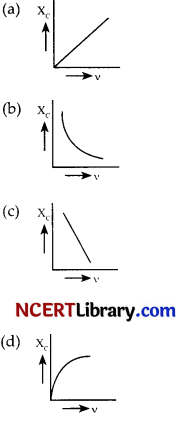
Answer:

Explanation:
XC = \(\frac { 1 }{ ωC }\) \(\frac { 1 }{ 2πvC }\)
XC ∝ \(\frac { 1 }{ v }\).
Question 8.
Which of the following can act as a source of electromagnetic waves?[1]
(a) A charge at rest
(b) A charge moving with a constant velocity
(c) A charge moving in a circular orbit
(d) None of these
Answer:
(c) A charge moving in a circular orbit
Explanation: A charge moving in a circular orbit can act as a source of electromagnetic waves as the e.m. waves are produced by accelerated charged particles only. A charge moving in a circular orbit has an accelerated motion.
Question 9.
If a current of 3 A flowing in the primary coil is reduced to zero in 0.01 s then the induced emf in the secondary coil is 1500 V, the mutual inductance between the two coils is:[1]
(a) 0.5 H
(b) 1.5 H
(c) 5 H
(d) 10 H
Answer:
(c) 5 H
Explanation:
∵ e = – M\(\frac { dl }{ dt }\)
1500 = – M\(\left(\frac{0-3}{0.01}\right)\)
M = \(\frac{1500 \times 0.01}{3}\)
= 5 H
Question 10.
Young’s double slit arrangement is contained in a transparent chamber. If the chamber is evacuated, then :[1]
(a) fringes will disappear
(b) fringe width will slightly increase
(c) fringe width will slightly decrease
(d) there will be no effect
Answer:
(d) there will be no effect
Explanation: Young’s double slit arrangement is contained in a transparent chamber. If the chamber is evacuated, then the position of maxima and minima will change but there will be no effect on fringe width.
Question 11.
Work function of a photoelectric material is 3.3 eV. What will be its threshold frequency?[1]
(a) 8 x 1010 Hz
(b) 8 x 1014 Hz
(c) 8 x 1020 Hz
(d) 8 x 1025 Hz
Answer:
(b) 8 x 1014 Hz
Explanation:
f = \(\frac{3.3 \times 1.6 \times 10^{-19} \mathrm{~J}}{6.626 \times 10^{-34} \mathrm{~J}-\mathrm{s}}\) = 8 x 1014 Hz
Question 12.
If Ep and Ek represent potential energy and kinetic energy respectively, of an orbital electron, then according to Bohr’s theory:[1]
(a) Ek = – \(\frac{E_p}{2}\)
(b) Ek = – Ep
(c) Ek = – 2 Ep
(d) Ek = – 2 Ep
Answer:
(a) Ek = – \(\frac{E_p}{2}\)
Explanation: Potential energy of an orbital electron, Ep = \(\frac{-Z e^2}{r}\)
Kinetic energy of an electron, Ek = \(\frac{Z e^2}{2r}\)
So, Ek = – \(\frac{E_p}{2}\)
![]()
Question 13.
The energy released in nuclear fission is due to:[1]
(a) the disappearance of few neutrons
(b) the total binding energy of fragments is more than the BE of parental element
(c) the total BE of fragments is less than BE of parental element
(d) the total BE of fragments is equal to the BE of parental element
Answer:
(b) the total binding energy of fragments is more than the BE of parental element
Explanation: The difference in mass appears as the energy released.
Question 14.
The frequency of an alternating voltage is 50 cps and its amplitude is 120 V. Then the r.m.s. value of voltage is:[1]
(a) 56.5 V
(b) 70.7 V
(c) 101.3 V
(d) 84.8 V
Answer:
(d) 84.8 V
Explanation: We know that,
Vr.m.s = \(\frac { 1 }{ 2 }\)
= \(\frac { 120 }{ 1.414 }\)
= 84.8 V.
Question 15.
Which of the following figure represents the electric field lines due to a single positive charge?[1]
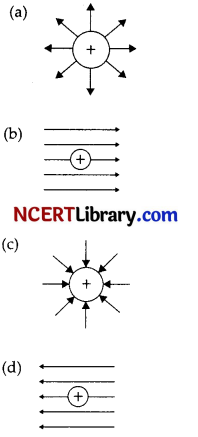
Answer:
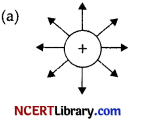
Explanation: The field lines of a single positive charge are radially outward.
(Direction: Question 16 to 18) Two statements are given-one labelled Assertion (A) and the other labelled Reason (R). Select the correct answer to these questions from the codes (a), (b), (c) and (d) as given below.[1]
(a) Both A and R are true and R is the correct explanation of A.
(b) Both A and R are true and R is not the correct explanation of A.
(c) A is true, but R is false.
(d) A is false and R is also false.
Question 16.
Assertion : Photoelectric effect supports the quantum nature of light.
Reason : It is because of the fact that electric charge of photoelectrons is quantised.[1]
Answer:
(c) A is true but R is false.
Explanation: Photoelectric effect supports quantum nature of light because when metal surface is faintly illuminated, photoelectrons leave surface immediately.
Question 17.
Assertion : Wavefronts obtained from light emitted by a point source in an isotropic medium are always spherical.
Reason: Speed of light in isotropic medium is not constant.[1]
Answer:
(c) A is true but R is false.
Explanation: When the speed of light is independent of direction, the secondary waves are spherical.
Question 18.
Assertion : If there is some gap between the conduction band and the valence band, electrons in the valence band all remain bound and no free electrons are available in the conduction band. Then the material is an insulator.
Reason : Resistance of insulators is very low.[1]
Answer:
(c) A is true but R is false.
Explanation: If there is some gap between the conduction band and the valence band, electrons in the valence band all remain bound and no free electrons in conduction band then it makes the material an insulator. Resistance of insulators is very high.
Section – B
Question 19.
(i) Why are infra-red waves often called heat waves? Explain.
(ii) What do you understand by the statement, “Electromagnetic waves transport momentum”?[2]
Answer:
(i) Infra-red waves are called heat waves because they raise the temperature of the object on which they fall. They also affect the photographic plate and are readily absorbed by most materials.
(ii) Electromagnetic waves transport momentum. This means that when an e.m. wave travels through space with energy U and speed c, then it transports linear momentum p = \(\frac { U }{ c }\). If a surface absorbs the waves completely, then momentum ‘p’ is delivered to the surface. If the surface reflects the wave, then momentum delivered by both incident and reflected wave adds on to give ‘2p’ momentum.
Question 20.
Two identical circular wires P and Q each of radius R and carrying current T are kept in perpendicular planes such that they have a common centre as shown in the figure. Find the magnitude and direction of the net magnetic field at the common centre of the two coils.[2]
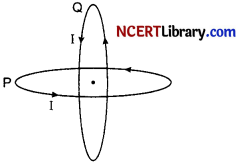
Answer:
Magnetic field produced by the two coils at their common centre having currents I1 and I2 radius a1 and a2 number of turns N1 and N2 respectively are given by :
B1 = \(\frac{\mu_0 \mathrm{~N}_1 \mathrm{I}_1}{2 a_1}\)
B2 = \(\frac{\mu_0 \mathrm{~N}_2 \mathrm{I}_2}{2 a_2}\)
The resultant field at the common centre is :
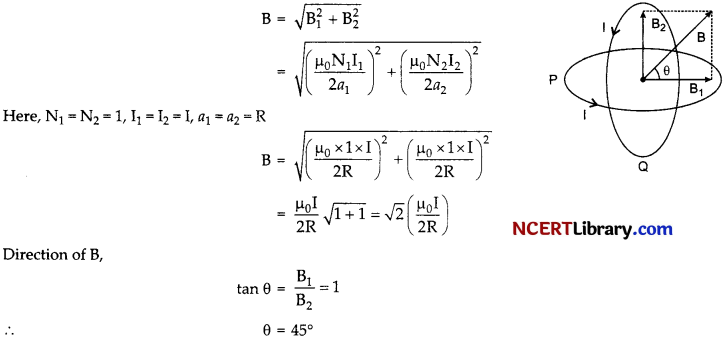
Hence, the net magnetic field is directed at an angle of 45° with either of the fields.
Question 21.
Two nuclei have mass numbers in the ratio 1: 8. What is the ratio of their nuclear radii?[2]
OR
Two nuclei have mass numbers in the ratio 27 :125. What is the ratio of the their nuclear radii?
Answer:
The radii of the nucleus is given by,
R = R0A1/3
which gives,
\(\frac{\mathrm{R}_1}{\mathrm{R}_2}=\left(\frac{\mathrm{A}_1}{\mathrm{~A}_2}\right)^{1 / 3}=\left(\frac{1}{8}\right)^{\mathrm{I} / 3}=\frac{1}{2}\)
So, the nuclear radii are in the ratio of 1: 2.
OR
Here,
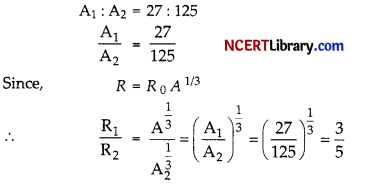
∴ The ratio of their radii = 3 : 5.
Question 22.
Calculate the radius of curvature of an equiconcave lens of refractive index 1.5, when it is kept in a medium of refractive index 1.4, to have a power of -5 D?[2]
Answer:
In an equiconcave lens, radius of curvature of both surfaces are equal
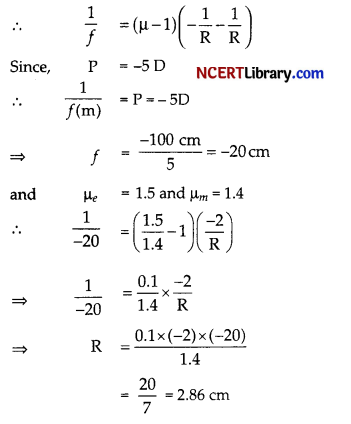
Question 23.
In a p-n junction diode the forward bias resistance is low as compared to the reverse bias resistance. Give reason.
OR
The graph shown in the figure represents a plot of current versus voltage for given semiconductor. Identify the region, if any, over which the semiconductor has a negative resistance.[2]
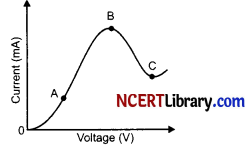
Answer:
When the p-n junction diode, is forward biased, the diode’s depletion layer or potential barrier shrinks. This can be considered as a practical short circuit.
Hence, resistance is negligible and current flow in forward bias is maximum.
Similarly, when it is reverse bias, depletion layer width (or potential barrier) increases. Hence, resistance increases and very small amount of current flow in reverse bias.
OR
Resistance of a material can be found out by the slope of the V-I curve. Part BC of the curve shows the negative resistance as with the increase in voltage, current decreases.
Question 24.
What speed should a galaxy move with respect to us so that the sodium line at 589.0 nm is observed at 589.6 nm?[2]
Answer:
As c = vλ,
\(\frac{\Delta v}{v}=-\frac{\Delta \lambda}{\lambda}=-\frac{v_{\text {radial }}}{c}\) (for small changes in v and X)
For ∆λ = 589.6 – 589.0 = + 0.6 nm
\(\frac{\Delta v}{v}=-\frac{\Delta \lambda}{\lambda}=-\frac{v_{\text {radial }}}{c}\)
or υradial ≅ + c\(\left(\frac{0.6}{589.0}\right)\)
= + 3.06 x 105 ms-1
= 306 km/s
Therefore, the galaxy is moving away from us.
![]()
Question 25.
Explain, using suitable diagrams, the difference in the behaviour of a
(i) conductor
(ii) dielectric in the presence of external electric field. Define the terms polarization of a dielectric and write its relation with susceptibility.[2]
Answer:
(i) Conductor:
Let E0 = External Electric field, and
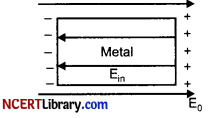
Ein = internal field created by the redistribution of electrons inside the metal.
When a conductor like a metal is subjected to external electric field, the electrons experience a force in the opposite direction collecting on the left hand side.
A positive charge is therefore, induced on the right hand side. This creates an opposite electric field (Ein) that balances out (E0).
∴ The net electric field inside the conductor becomes zero.
Here, E0 is the external field and Ein is the internal field created by the re-distribution of electrons inside the metal.
(ii) Dielectric : When external electric field is applied, dipoles are created for non-polar dielectrics and in case of polar dielectrics dipoles are aligned. An internal field is created such that it reduces the external field. The placement of dipoles is as shown in the given figure.
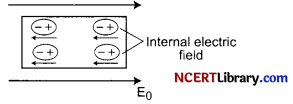
The dipole moment per unit volume of the polarised dielectric is known as the polarisation of a dielectric. It is denoted by P.
The formula for polarization is given by,
P = χ0 ε0 E;
χ0 is susceptibility and E is the electric field.
Section – C
Question 26.
Deduce an expression for the frequency of revolution of a charged particle in a magnetic field and show that it is independent of velocity or energy of the particle.[3]
Answer:
When a charged particle having charge q moves inside a magnetic field \(\vec{B}\) having velocity υ, it experiences a force, which is given by :
\(\vec{F}\) = q(\(\vec{v}\) x \(\vec{B}\))
Here, \(\vec{v}\) is perpendicular to \(\vec{B}\),
\(\vec{F}\) is the force on the charged particle which behaves as the centripetal force and make it move in a circular path.
Let m be the mass of the charged particle and r be the radius of the circular path.
∴ q(\(\vec{v}\) x \(\vec{B}\)) = \(\frac{m v^2}{r}\)
υ and B are at right angles :
∴ qυB = \(\frac{m v^2}{r}\)
r = \(\frac { mv }{ Bq }\)
Time period of circular motion of the charged particle can be calculated by,
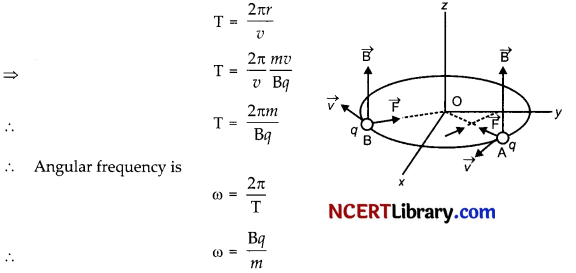
Therefore, the frequency of the revolution of the charged particle is independent of the velocity or the energy of the particle.
Question 27.
Two identical loops P and Q each of radius 5 cm are lying in perpendicular planes such that they have a common centre as shown in the figure. Find the magnitude and direction of the net magnetic field at the common centre of the two coils, if they carry currents equal to 3 A and 4 A respectively.[3]
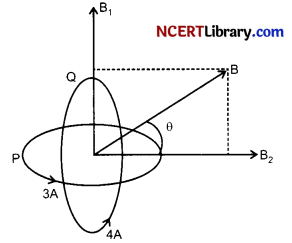
Answer:
Magnetic field due to loop P at centre
B1 = \(\frac{\mu_0}{2 \mathrm{R}} \cdot \mathrm{I}_1\)
B1 = \(\frac{\mu_0}{2} \times \frac{3}{5 \times 10^{-2}}\)
Similarly, Magnetic field due to loop Q at centre
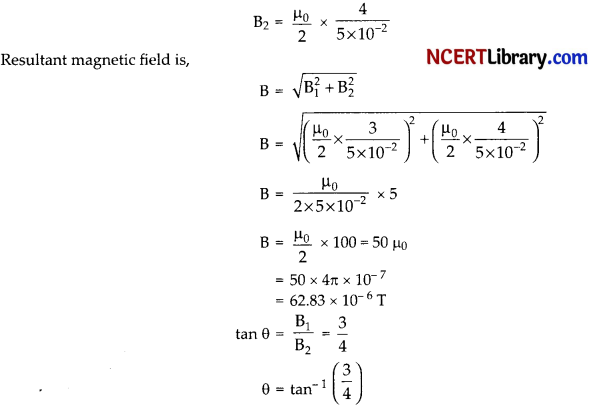
Thus, direction of magnetic field makes an angle 0 with the vertical.
Question 28.
An a.c. source of voltage V = V0 sin ωt is connected to a series combination of L, C and R. Use the phasor diagram to obtain expressions for impedance of the circuit and phase angle between voltage and current. Find the condition when current will be in phase with the voltage. What is the circuit in this condition called?[3]
OR
In a series LR circuit XL = R and power factor of the circuit is P1. When capacitor with capacitance C such that XL = XC is put in series, the power factor becomes P2. Calculate \(\frac{P_1}{P_2}\).
Answer:
Let a series LCR circuit is connected to an a.c. source V (Fig). We take the voltage of the source to be V = V0 sin ωt

The a.c. current in each element is the same at any time, having the same amplitude and phase. It is given
by,
I = I0 sin (ωt + Φ)
Let VL, VR, VC and V represent the voltage across the inductor, resistor, capacitor and the source respectively.
Let VL > VC
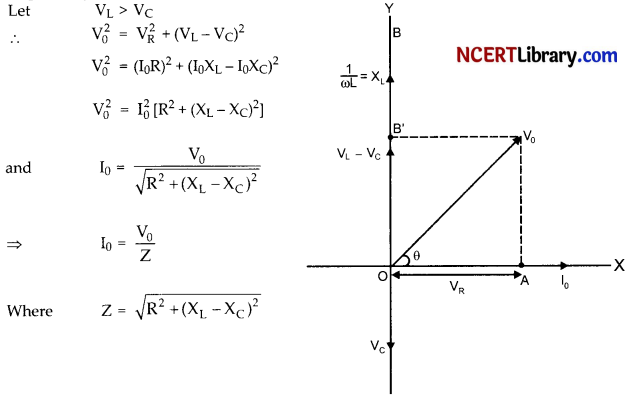
It is called the impedance in an a.c. circuit
From the figure,
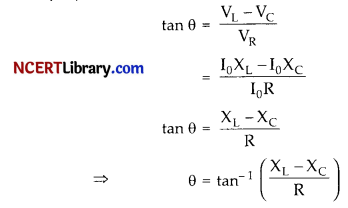
Condition: The current will be in phase with the voltage at resonance condition.
At resonance condition,
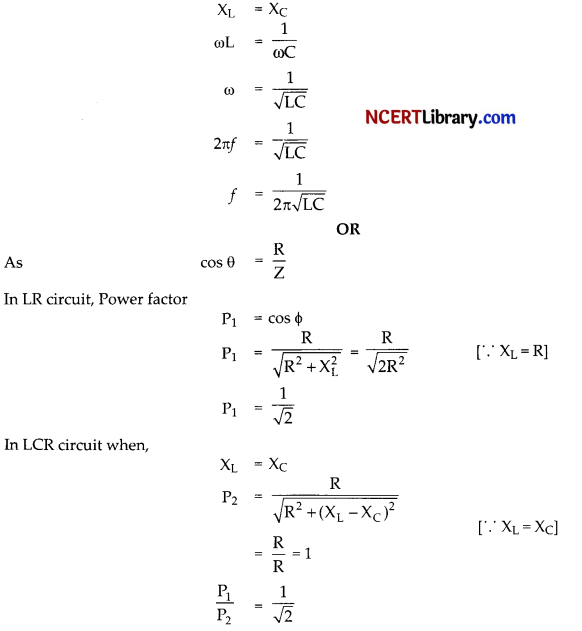
Question 29.
The given graph shows the variation of photoelectric current (I) versus applied voltage (V) for two different photosensitive materials and for two different intensities of the incident radiations. Identify the pairs of curves that correspond to different materials but same intensity of incident radiation.[3]
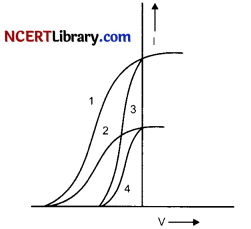
Write Einstein photoelectric equation? State clearly the three salient features observe in photoelectric effect, which can be explained on the basis of this equation?
Answer:
Curves 1 and 2 correspond to similar materials while curves 3 and 4 represent different materials, since the value of stopping potential for 1, 2 and 3, 4 are the same. For the given frequency of the incident radiation, the stopping potential is independent of its intensity.
So, the pairs of curves (1 and 3) and (2 and 4) correspond to different materials but same intensity of incident radiation.
OR
Einstein photoelectric equation :
Kmax = \(\frac { 1 }{ 2 }\)mv² = hV-Φ0
Where Φ0 is work function. If the energy of the photon absorbed by the electron is less than the work function Φ0 of the metal, then the electron will not be emitted. Therefore, for the given metal, the threshold frequency of light be v0, then an amount of energy hv0 of the photon of light will be spent in ejecting the electron out of the metal, that is, it will be equal to the work function W. Thus,
W = hv0
Thus. EK = hv – hv0
\(\frac { 1 }{ 2 }\)mv² max = h(v – v0)
This equation is called ‘Einstein Photoelectric equation’.
Salient features:
- The stopping potential and hence the maximum kinetic energy of emitted electrons varies linearly with the frequency of incident radiation.
- There exists a minimum cut-off frequency vo, for which the stopping potential is zero.
- Photoelectric emission is instantaneous.
Question 30.
A photon emitted during the de-excitation of electron from a state n the first excited state in a hydrogen atom, irradiates a metallic cathode of work function 2 eV, in a photo cell, with a stopping potential of 0.55 V. Obtain the value of the quantum number of the state n.[3]
Answer:
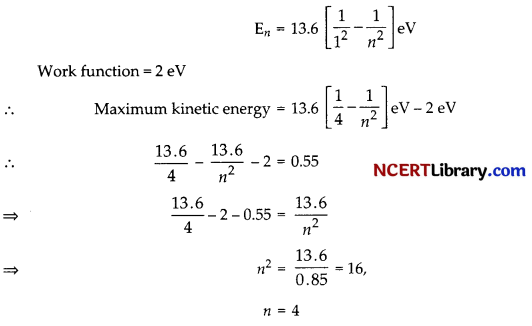
Section – D
Question 31.
(a) If one of the two electrons of a H2 molecule is removed, we get a hydrogen molecular ion H2+. In the ground state of an H2+, the two protons are separated by roughly 1.5 Å, and the electron is roughly 1 A from each proton. Determine the potential energy of the system. Specify your choice of the zero of potential energy. [5]
(b) Two tiny spheres carrying charges 1.5 μC and 2.5 μC are located 30 cm apart. Find the potential and electric field:
(i) at the mid-point of the line joining the two charges, and
(ii) at a point 10 cm from this mid-point in a plane normal to the line and passing through the mid-point.
OR
(a) (i) Three point charges q, – 4q and 2q are placed at the vertices of an equilateral triangle ABC of side as shown in the figure. Obtain the expression for the magnitude of the resultant electric force acting on the charge q.
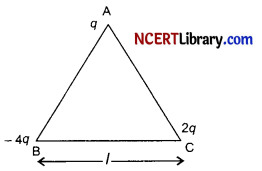
(ii) Find out the amount of the work done to separate the charges at infinite distance.
(b) Consider the charges q, q and – q placed at the vertices of an equilateral triangle, as shown in given figure. What is the force on each charge?
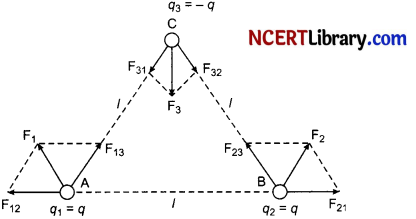
Answer:
(a) The system of two protons and one electron is represented in the given figure.
The potential energy of the system is,
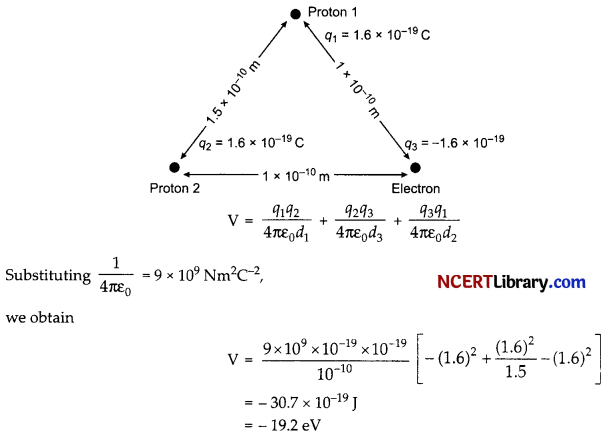
Therefore, the potential energy of the system is – 19.2 eV.
(b) Two charges placed at points A and B are shown in the given figure. O is the mid-point of the line joining the two charges.

Magnitude of charge located at A,
q1 = 1.5 μC
Magnitude of charge located at B,
q2 = 2.5 μC
Distance between the two charges,
d = 30 cm= 0.3 m
(i) Let V1 and E1 are the electric potential and electric field respectively at O.
V1 = Potential due to charge at A + Potential due to charge at B
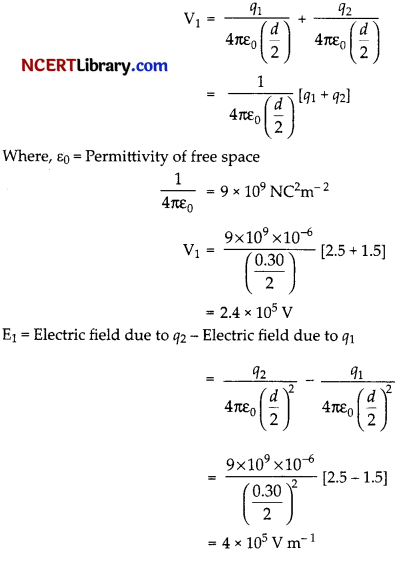
Therefore, the potential at a point 10 cm (perpendicular to the mid-point) is 2.0 x 10-5 Vm-1.
The field is directed from the larger charge to the smaller charge.
(ii) Consider a point Z such that normal distance OZ = 10 cm = 0.1 m, as shown in the following figure:

Let, V2 and E2 are the electric potential and electric field respectively at Z.
It can be observed from one figure that distance,
BZ = AZ
= \(\sqrt{(0.10)^2+(0.15)^2}\)
= 0.18 m
V2 = Electric potential due to A + Electric potential due to B
= \(\frac{q_1}{4 \pi \varepsilon_0(\mathrm{AZ})}+\frac{q_2}{4 \pi \varepsilon_0(\mathrm{BZ})}\)
= \(\frac{9 \times 10^9 \times 10^{-6}}{0.18}\)[1.5 + 2.5]
= 2 x 10-5 V
Electric field due to q1 at Z,
EA = \(\frac{q_1}{4 \pi \varepsilon_0(\mathrm{AZ})^2}\)
= \(\frac{9 \times 10^9 \times 1.5 \times 10^{-6}}{(0.18)^2}[1.5 + 2.5]\)
= 0.416 x 106 V m-1
Electric field due to q2 at Z,
EB = \(\frac{q_2}{4 \pi \varepsilon_0(B Z)^2}\)
= \(\frac{9 \times 10^9 \times 2.5 \times 10^{-6}}{(0.18)^2}[1.5 + 2.5]\)
= 0.416 x 106 V m-1
The resultant field intensity at Z,
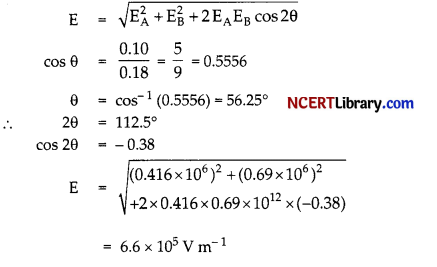
Therefore, the potential at a point 10 cm (perpendicular to the mid-point) is 2.0 x 105 V and electric field is 6.6 x 105 V m-1.
OR
(a) (i) Electric force at A due to charge 2q,
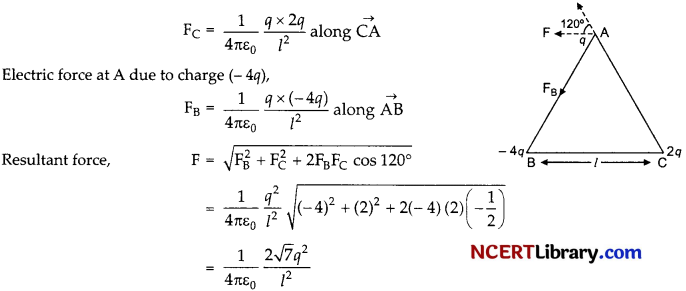
(ii) Work done to separate the charge to infinity :
Initial potential energy,
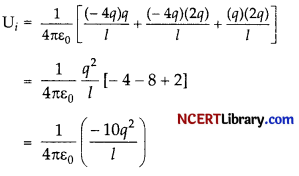
Final potential energy,
Uf = 0
Thus, work done,
\(U_f-U_i=0-\left(\frac{-10 q^2}{4 \pi \varepsilon_0 l}\right)=\frac{10 q^2}{4 \pi \varepsilon_0 l}[1.5 + 2.5]\)
(b) The forces acting on charge q at A, due to charges q at B and -q at C are F12 along BA and F13 along AC respectively, as shown in figure from the parallelogram law, the total force F1 on the charge q at A is given
by F1 = F \(\hat{r}_1\) where \(\hat{r}_1\) is a unit vector along BC.
The force of attraction or repulsion for each pair of charges has the same magnitude
F = \(\frac{q^2}{4 \pi \varepsilon_0 l^2}\)
The total force F2 on charge q at B is thus F2 = F \(\hat{r}_2\), where \(\hat{r}_2\) a unit vector along AC.
Similarly, the total force on charge – q at C is F3 = \(\sqrt{3}\) F \(\hat{n}\), where n is the unit vector along the direction bisecting the ∠BCA.
It is interesting to see that the sum of the forces on the three charges is zero, i.e.,
F1 + F2 + F3 = 0
Question 32.
(a) Define an equipotential surface. Draw equipotential surfaces :[5]
(i) in the case of a single point charge and,
(ii) in a constant electric field in Z-direction.
Why the equipotential surfaces about a single charge are not equidistant?
(iii) Can electric field exist tangential to an equipotential surface? Give reason.
(b) Show that energy stored in a capacitor is given by E = \(\frac { 1 }{ 2 }\) CV².
OR
(a) If two similar large plates each of area A having surface charge densities + a and – a are separated by a distance in air. Find the expressions for:
(i) field at points between the two plates and on outer sides of plates. Specify the direction of field in each case.
(ii) the potential difference between the plates.
(iii) the capacitance of capacitor so formed.
(b) Figure shows two identical capacitors, C1 and C2 each of 1 μF capacitance connected to a battery of 6 V. Initially switch ‘S’ is closed. After sometime ‘S’ is left open and dielectric slabs of dielectric constant k = 3 are inserted to fill completely the space between the plates of the two capacitors.
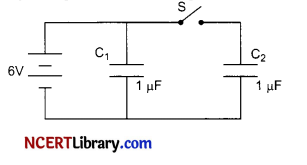
How will the (i) charge and (ii) potential difference between the plates of the capacitors be affected after the slabs are inserted.
Answer:
(a) An equipotential surface is the surface which has same potential at its every point.
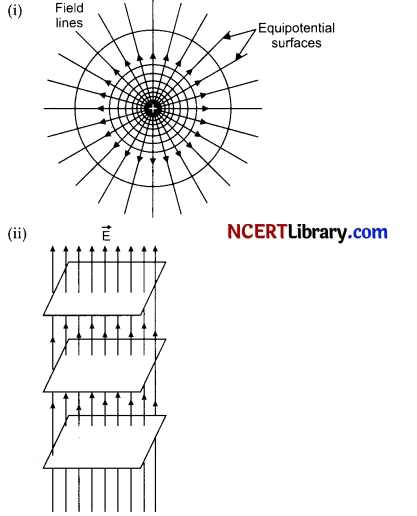
The electric field due to single charge is not constant, this is the reason why the equipotential surfaces about a single charge are not equidistant.
(iii) No, electric field cannot exist tangential to an equipotential surface. If it happen then a charged particle will experience a force along the tangential line and can move along it. As a charged particle can move only due to the potential difference i.e., along the direction of charge of potential, this contradicts the concept of an equipotential surface.
(b) Let the capacitor (C) is connected across a battery of voltage V (volts). The process of charging capacitor is equivalent to transferring charges from one plate to another plate of capacitor.
As soon as charging of capacitor starts there is a potential difference between plates. So to transfer charges against the potential difference some work is to be done and this work gets stored as electrostatic potential energy in capacitor.
Let dq be the charge transferred against the potential difference V, then work done is
dW = Vdq
= \(\frac { q }{ C }\)dq
Total work done to transfer charge q, is
U = \(\int_0^q d \mathrm{~W}=\int_0^q \mathrm{~V} d q=\int_0^9 \frac{q}{\mathrm{C}} d q\)
U = \(\frac{q^2}{2 C}=\frac{1}{2} C V^2\)
OR
(a) (i) Consider a parallel plate capacitor with two identical plates X and Y, each having an area of A, and separated by a distance d. Let the space between the plates be filled by a dielectric medium with its dielectric constant as K and a be the surface charge density on each of the plates.
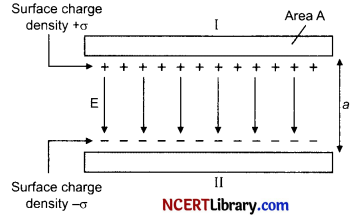
Surface charge density of plate 1
σ = \(\frac { Q }{ A }\)
and that of plate 2 is σ
Electric field in outer region I,
E = \(\frac{\sigma}{2 \varepsilon_0}-\frac{\sigma}{2 \varepsilon_0}\) = 0
Electric field in outer region II,
E = \(\frac{\sigma}{2 \varepsilon_0}-\frac{\sigma}{2 \varepsilon_0}\) = 0
The inner region between plates 1 and 2. In the electric fields due to the two charged plates add up.
So,
E = \(\frac{\sigma}{2 \varepsilon_0}+\frac{\sigma}{2 \varepsilon_0}=\frac{\sigma}{\varepsilon_0}\) = 0
(ii) For uniform electric field potential difference is simply the electric field multiplied by the distance between the plates, i.e.,
V = Ed = \(\frac{1}{\varepsilon_0} \frac{\mathrm{Q} d}{\mathrm{~A}}\)
(iii) Capacitance of parallel plates capacitor,
C = \(\frac { Q }{ V }\)
= \(\frac{\mathrm{Q} \varepsilon_0 \mathrm{~A}}{\mathrm{Qd}}\)
= \(\frac{\varepsilon_0 \mathrm{~A}}{d}\)
(b) When, switch ‘S’ is closed,
Potential difference across C1 = Potential difference across C2 = 6 V
V1 = V2 = 6V
q1 = q2 = 1 μF x 6V = 6 μC
When switch ‘S’ is opened, the potential difference across C1 remains 6 V, while the charge on capacitor C2 remains 6 μC.
After insertion of dielectric slab (k = 3) between the plates of each capacitor, the new capacitance of each capacitor becomes
C”1 = 3 x 1 μF = 3 μF
C’2 = 3 μF
(i) Now, charge on capacitor C1,
q1 = C’1V1 = 3 x 6 = 18 μC
(ii) When S is open, potential difference across C2
= \(\mathrm{V}_2^{\prime}=\frac{q_2}{\mathrm{C}_2^{\prime}}=\frac{6 \mu \mathrm{C}}{3 \mu \mathrm{F}}=2 \mathrm{~V}\)
![]()
Question 33.
(a) Draw the ray diagram showing refraction of ray of light through a glass prism. Derive the expression for the refractive index p of the material of prism in terms of the angle of prism A and angle of minimum deviation 8m.
(b) A ray of light PQ enters an isosceles right angled prism ABC of refractive index 1.5 as shown in figure.
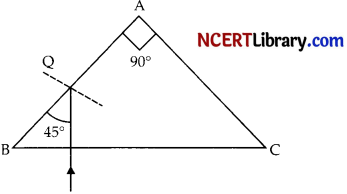
(i) Trace the path of the ray through the prism.
(ii) What will be the effect on the path of the ray if the refractive index of the prism is 1.4?
OR
(a) Plot a graph to show variation of the angle of deviation as a function of angle of incidence for light passing through a prism. Derive an expression for refractive index of the prism in terms of angle of minimum deviation and angle of prism.
(b) (i) What is dispersion of light? What is its cause?
(ii) A ray of light incident normally on one face of a right isosceles prism is totally reflected as shown in fig. What must be the minimum value of refractive index of glass ? Give relevant calculations.
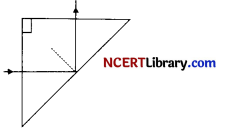
Answer:
PQ = incident ray
QR = refracted ray
RS = emergent ray
∠A = angle of prism
∠i = angle of incidence
∠r1 = angle of refraction
∠e = angle of emergence
∠δ = angle of deviation
Consider, the above diagram and µ as the refractive index of the prism.
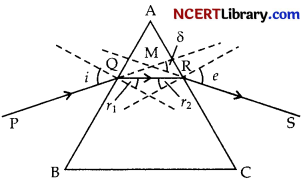
In case of minimum deviation, ∠r1 = ∠r2 = ∠r
and A = ∠r1 + ∠r2
So, A = ∠r + ∠r = 2 ∠r
or ∠r = \(\frac { A }{ 2 }\)
Now again,
A + δ = i + e = 2i
or i = \(\frac { A+δ }{ 2 }\)
Now from Snell’s law
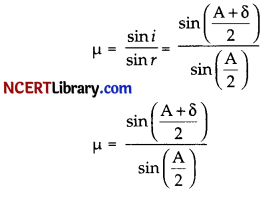
is the required expression,
(b) (i) For critical angle,
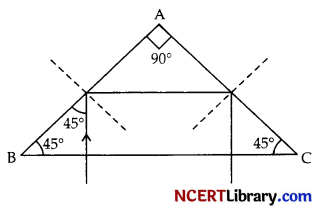
Sin C = \(\frac { 1 }{ μ }\) = \(\frac { 1 }{ 1.5 }\) = \(\frac { 2 }{ 3 }\)
C = sin-1(\(\frac { 5 }{ 7 }\)) = 45°9′
Since, incident angle is less than the critical angle. Then total internal reflection will not occur.
OR
(a)
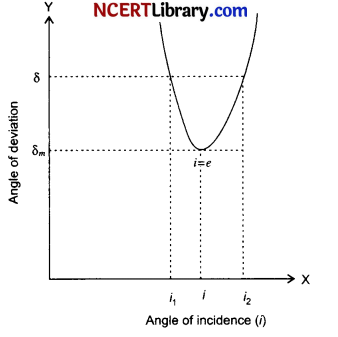
From figure, δ = δm, i = e which implies r1 = r2
2r = A, or r = \(\frac { A }{ 2 }\)
8 = i + e – A
δm = 2i – A
i = \(\frac{\mathrm{A}+\delta_m}{2}\)
μ = \(\frac{\sin i}{\sin r}=\frac{\sin \left(\frac{\mathrm{A}+\delta_m}{2}\right)}{\sin \mathrm{A} / 2}\)
(b) (i) Dispersion of Light: Dispersion is often observed as light passes through a triangular prism. Upon passing through the prism, the white light is separated into its component colours, red, orange, yellow, green, blue, indigo and violet. The separation of visible light into its different colours is known as dispersion. Dispersion occurs because for different colour of light, a transparent medium will have different refractive indices (g) as different colours have different speed of light in transparent medium.
(ii) For total internal reflection :
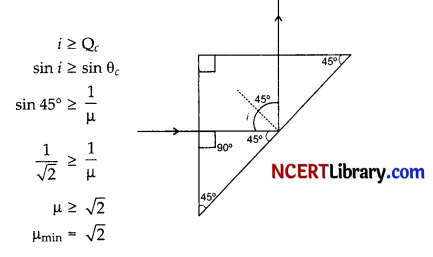
Section – E
Question 34.
Case Study: Sparking Brilliance of Diamond:
Read the following paragraph and answer the questions.
The total internal reflection of the light is used in polishing diamonds to create a sparking brilliance. By polishing the diamond with specific cuts, it is adjusted the most of the light rays approaching the surface are incident with an angle of incidence more than critical angle. Hence, they suffer multiple reflections and ultimately come out of diamond from the top. This gives the diamond a sparking brilliance.[5]
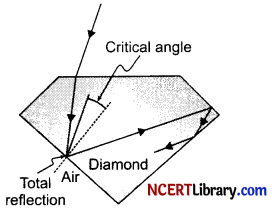
(i) Light cannot easily escape a diamond without multiple internal reflections. Why?
(ii) The critical angle for a diamond is 24.4°. What is the refractive index of the diamond?
(iii) Give the reason for the extraordinary sparkle of suitable cut diamond.
OR
(iii) A diamond is immersed in a liquid with a refractive index greater than water. What will critical angle for total internal reflection.
Answer:
(i) Its critical angle with reference to air is too small. Therefore, multiple internal reflection light cannot escope easily.
(ii) Sin C = \(\frac { 1 }{ μ }\)
μ = \(\frac { 1 }{ sin C }\)
= \(\frac { 1 }{ sin 24.4° }\)
= 2.42
(iii) Due to High refractive index of diamond
OR
On immersing a diamond in a liquid with refractive index greater than water, the critical angle will increase.
Question 35.
Case Study: Light emitting diode
Read the following paragraph and answer the questions.
Rectifier is a device which is used for converting alternating current or voltage into direct current or voltage. Its working is based on the fact that the resistance of p-n junction becomes low when forward biased and becomes high when reverse biased. A half-wave rectifier uses only a single diode while a full wave rectifier uses two diodes as shown in figures (a) and (b).[5]

(i) If the rms value of sinusoidal input to a full wave rectifier is \(\frac{V_0}{\sqrt{2}}\) then what will be the rms value of the rectifier’s output?
(ii) In the diagram, the input ac is across the terminals A and C. How does the output across B and D rectified.
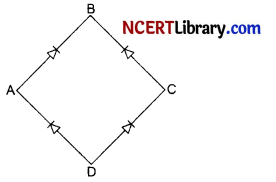
(iii) A p-n junction (D) shown in the figure can act as a rectifier. An alternating current source (V) is connected in the circuit. How the current (I) in the resistor (R) can be shown?

OR
(iii) With an ac input from 50 Hz power line, What will be the value of ripple frequency ?
Answer:
(i) Vrms = \(\frac{V_0}{\sqrt{2}}\)
(ii) For every half cycle of an ac input across the terminal A and C, the output is full wave rectified.
(iii)
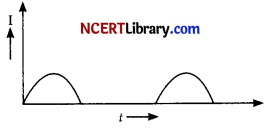
OR
(iii) 50 Hz in the dc output of half wave rectifier and 100 Hz in dc output of full wave rectifier.